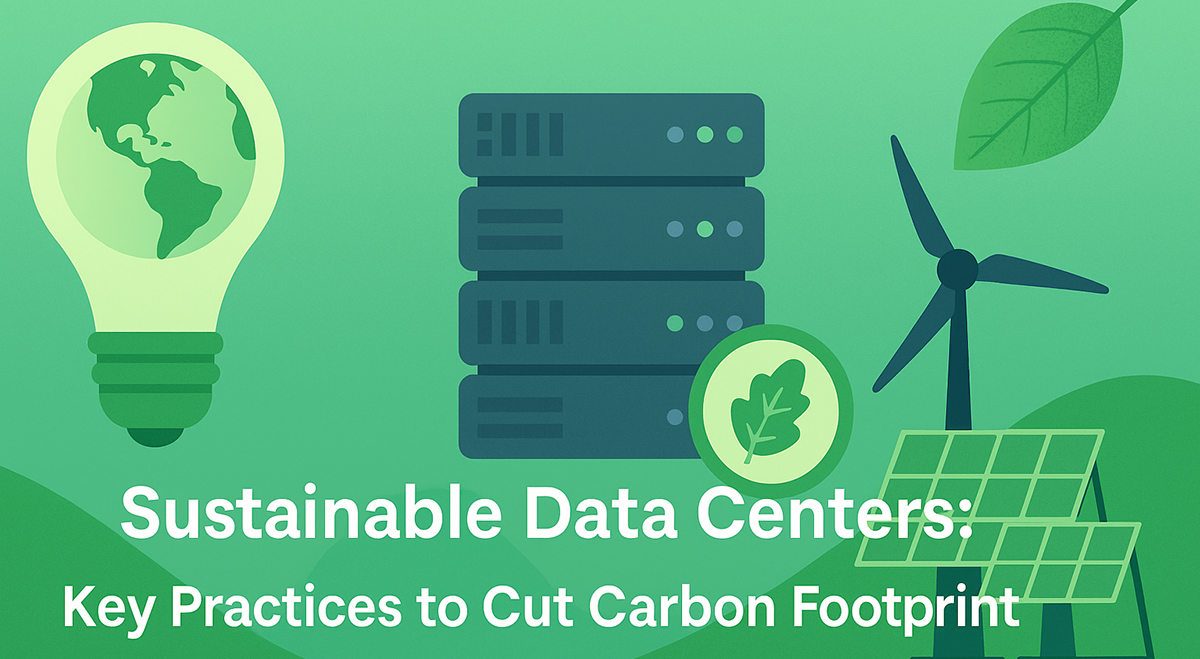No products in the cart.
 Introduction
Introduction
Let’s be real—data centers are the invisible workhorses of our digital world. But while they’re powering your cloud backups and late-night Netflix binges, they’re also guzzling energy at an eye-watering rate. The good news? Sustainable IT practices are no longer just a corporate buzzword—they’re fast becoming a necessity.
Understanding the Carbon Footprint of Data Centers
Data centers are power-hungry beasts. Maintaining large-scale, 24/7 server operations entails significant energy consumption, frequently reliant on fossil fuel-based power generation. Combine that with outdated cooling systems and a constant cycle of hardware upgrades, and you’ve got a hefty carbon footprint.
The Push Toward Green IT
So what’s Green IT? It’s all about designing, using, and disposing of IT infrastructure in ways that reduce environmental impact. With tightening regulations, rising electricity costs, and eco-conscious customers, companies are now under pressure to act.
Energy Efficiency Measures
Modern Cooling Techniques
In most data centers, nearly 40% of energy usage is dedicated to cooling infrastructure. That’s where innovative methods like free cooling (which uses outside air) and liquid cooling (which transfers heat more efficiently) come in. These technologies can slash energy usage dramatically.
Virtualization and Consolidation
Running several virtual servers on a single physical host enables organizations to optimize resource utilization, thereby reducing hardware dependency, lowering heat generation, and minimizing cooling and energy costs.
Transition to Renewable Energy
Solar, Wind, and Hydropower Adoption
Prominent firms including Google and Microsoft are now leveraging renewable energy to sustain their data center operations. Solar panels, wind farms, and hydro-powered systems are transforming how we think about IT energy consumption.
Power Purchase Agreements (PPAs)
PPAs allow data center operators to lock in long-term access to clean energy without installing the infrastructure themselves. It’s like getting VIP access to green electricity on demand.
Design Innovations in Green Data Centers
Modular Data Centers
Think Lego blocks for tech infrastructure. Modular designs are pre-engineered, more energy-efficient, and scalable. They eliminate waste from over-provisioning and support quicker deployment.
Location and Architecture Optimization
Placing data centers in cooler climates or near renewable energy sources naturally reduces power needs. Smart architectural choices—like using reflective roofing or airflow optimization—add to the savings.
Intelligent Resource Management
AI for Load Balancing
Machine learning algorithms can now predict workload spikes and redistribute computing power as needed. The result? Less idle time, less energy waste.
Dynamic Power Scaling
When systems aren’t in use, dynamic scaling reduces the voltage and frequency—essentially putting servers in a low-power mode without affecting performance.
Cloud Computing’s Role in Sustainability
Cloud computing isn’t just convenient—it’s sustainable. Through resource consolidation, cloud providers effectively reduce inefficiencies caused by idle or underused servers. A single hyperscale data center can serve thousands of users with a smaller environmental impact per capita.
The Importance of Monitoring and Metrics
Carbon Accounting Tools
You can’t improve what you can’t measure. Carbon accounting tools provide granular insights into where emissions are coming from and how to reduce them.
Key Performance Indicators (KPIs)
Metrics like Power Usage Effectiveness (PUE), Water Usage Effectiveness (WUE), and Data Center Infrastructure Efficiency (DCiE) are now the industry’s north stars for sustainability.
Tackling E-Waste Responsibly
Recycling and Refurbishing Equipment
Before tossing that outdated server, consider refurbishment. Refurbished hardware can perform like new and avoids the environmental toll of manufacturing replacements.
Responsible Disposal Programs
Using certified e-waste recycling programs ensures toxic components are handled safely and valuable materials like gold and copper are recovered.
Policies and Compliance
Global Standards and Certifications
Certifications like LEED, ISO 14001, and Energy Star validate your efforts and offer guidance on best practices.
Government Regulations
Regulations are tightening globally. From carbon taxes to mandatory disclosures, staying compliant is now essential for data centers aiming to compete.
The Human Element: Culture and Training
Even the greenest tech means nothing if your team isn’t on board. Encourage a sustainability-first mindset with regular training, eco-friendly policies, and incentives for innovation.
Challenges to Implementation
Let’s not sugarcoat it transitioning to sustainable IT isn’t easy. Legacy systems, high upfront costs, and technical limitations can slow things down. But with clear ROI over time, it’s a smart long-term play.
The Future of Sustainable IT
We’re heading toward carbon-negative data centers, AI-powered sustainability models, and a circular IT economy where reuse becomes the norm. The future isn’t just green—it’s intelligent.
📌 Be Ready for the Unexpected
💾 Back up smart. 💥 Recover fast.
With actsupport, your critical data is protected with enterprise-grade backup and recovery solutions.
🔐 Peace of mind starts here.
Conclusion
Sustainable IT practices are more than just a trend—they’re the backbone of a future-ready digital ecosystem. Data centers that cut emissions, use clean energy, and reduce waste aren’t just good for the planet—they’re great for business too. It’s time to reimagine IT not just as infrastructure, but as a lever for climate action.
Stay updated! Follow us on social media! Facebook, Twitter, LinkedIn
Check out our newest blog entry (Building a Resilient Hybrid Cloud Strategy)
Subscribe to get free blog content to your Inbox


